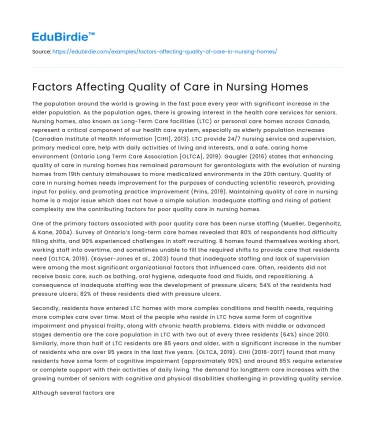The population around the world is growing in the fast pace every year with significant increase in the elder population. As the population ages, there is growing interest in the health care services for seniors. Nursing homes, also known as Long-Term Care facilities (LTC) or personal care homes across Canada, represent a critical component of our health care system, especially as elderly population increases (Canadian Institute of Health Information [CIHI], 2013). LTC provide 24/7 nursing service and supervision, primary medical care, help with daily activities of living and interests, and a safe, caring home environment (Ontario Long Term Care Association [OLTCA], 2019). Gaugler (2016) states that enhancing quality of care in nursing homes has remained paramount for gerontologists with the evolution of nursing homes from 19th century almshouses to more medicalized environments in the 20th century. Quality of care in nursing homes needs improvement for the purposes of conducting scientific research, providing input for policy, and promoting practice improvement (Prins, 2019). Maintaining quality of care in nursing home is a major issue which does not have a simple solution. Inadequate staffing and rising of patient complexity are the contributing factors for poor quality care in nursing homes.
One of the primary factors associated with poor quality care has been nurse staffing (Mueller, Degenholtz, & Kane, 2004). Survey of Ontario’s long-term care homes revealed that 80% of respondents had difficulty filling shifts, and 90% experienced challenges in staff recruiting. 8 homes found themselves working short, working staff into overtime, and sometimes unable to fill the required shifts to provide care that residents need (OLTCA, 2019). (Kayser-Jones et al., 2003) found that inadequate staffing and lack of supervision were among the most significant organizational factors that influenced care. Often, residents did not receive basic care, such as bathing, oral hygiene, adequate food and fluids, and repositioning. A consequence of inadequate staffing was the development of pressure ulcers; 54% of the residents had pressure ulcers; 82% of these residents died with pressure ulcers.
Save your time!
We can take care of your essay
- Proper editing and formatting
- Free revision, title page, and bibliography
- Flexible prices and money-back guarantee
Secondly, residents have entered LTC homes with more complex conditions and health needs, requiring more complex care over time. Most of the people who reside in LTC have some form of cognitive impairment and physical frailty, along with chronic health problems. Elders with middle or advanced stages dementia are the core population in LTC with two out of every three residents (64%) since 2010. Similarly, more than half of LTC residents are 85 years and older, with a significant increase in the number of residents who are over 95 years in the last five years. (OLTCA, 2019). CIHI (2016-2017) found that many residents have some form of cognitive impairment (approximately 90%) and around 85% require extensive or complete support with their activities of daily living. The demand for long‐term care increases with the growing number of seniors with cognitive and physical disabilities challenging in providing quality service.
Although several factors are responsible for influencing nursing home’s quality care, two main of them have been discussed in this paper.






 Stuck on your essay?
Stuck on your essay?

